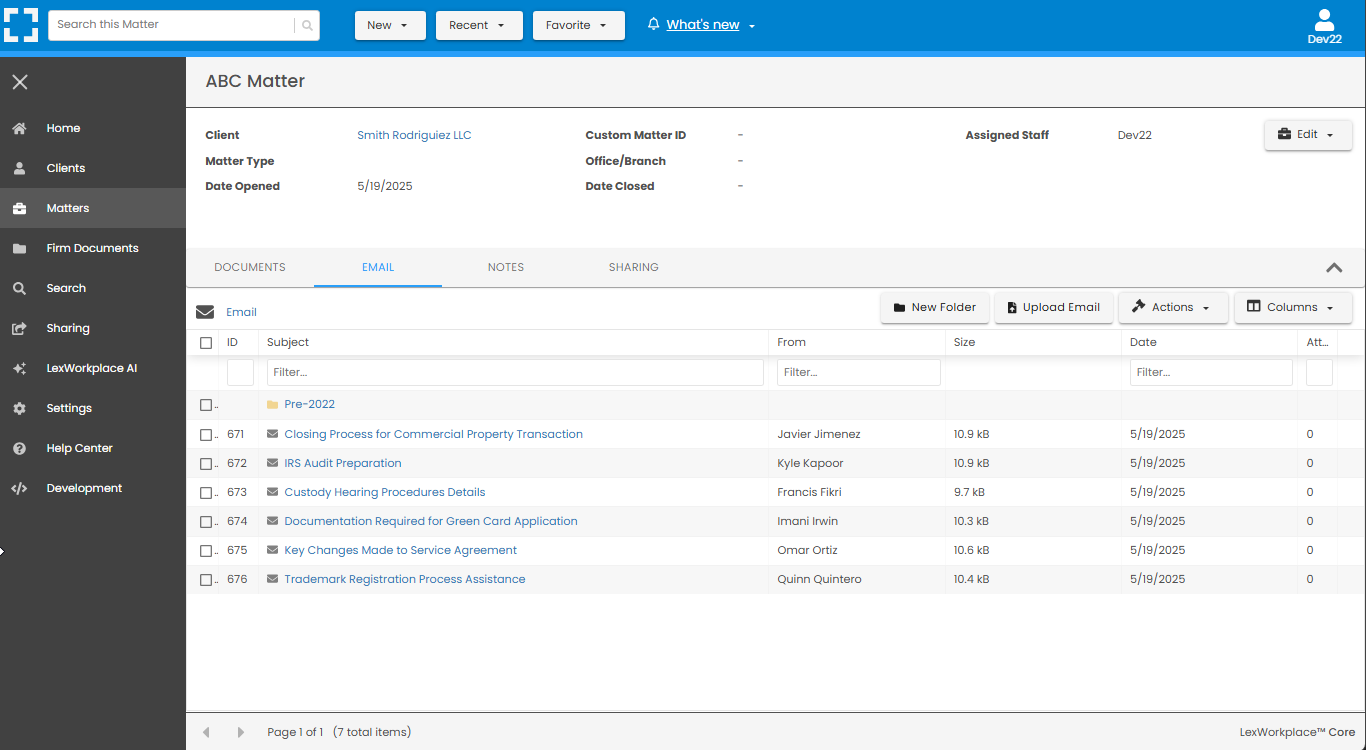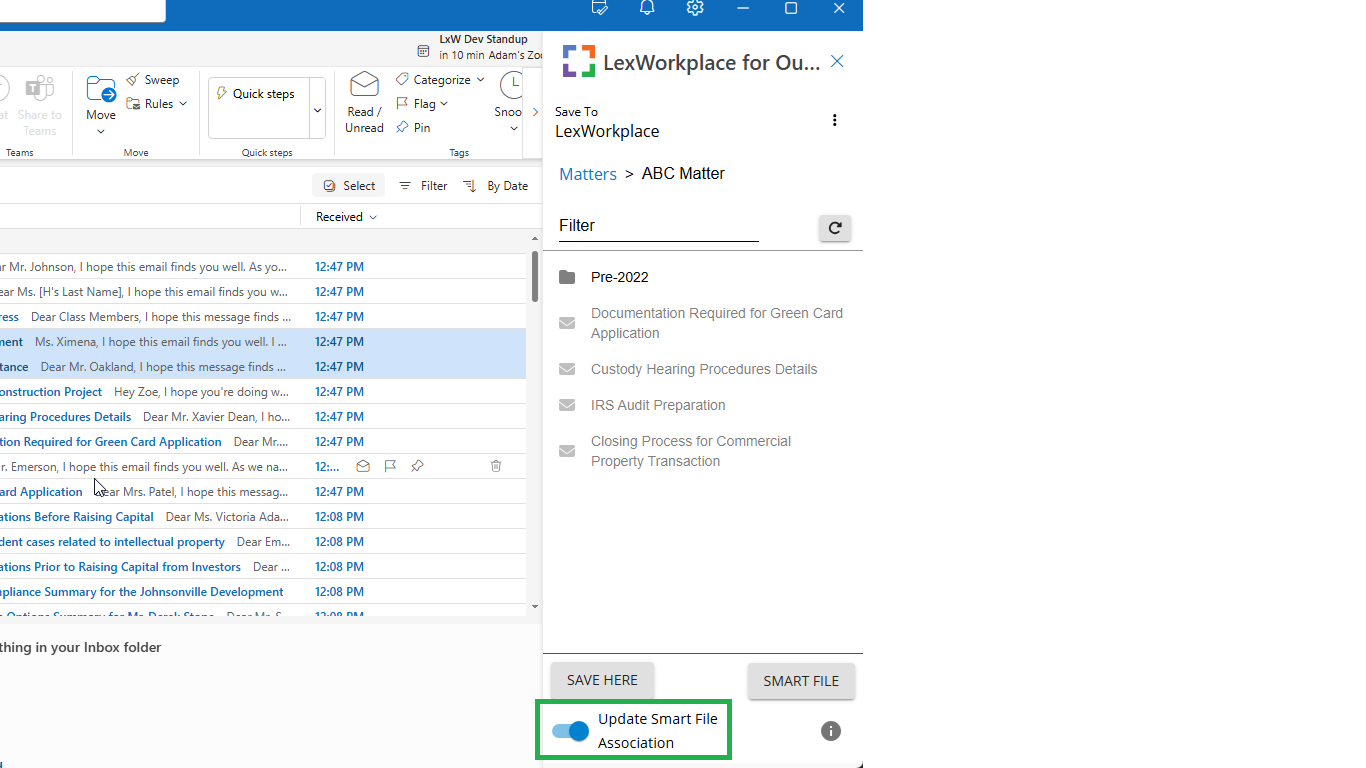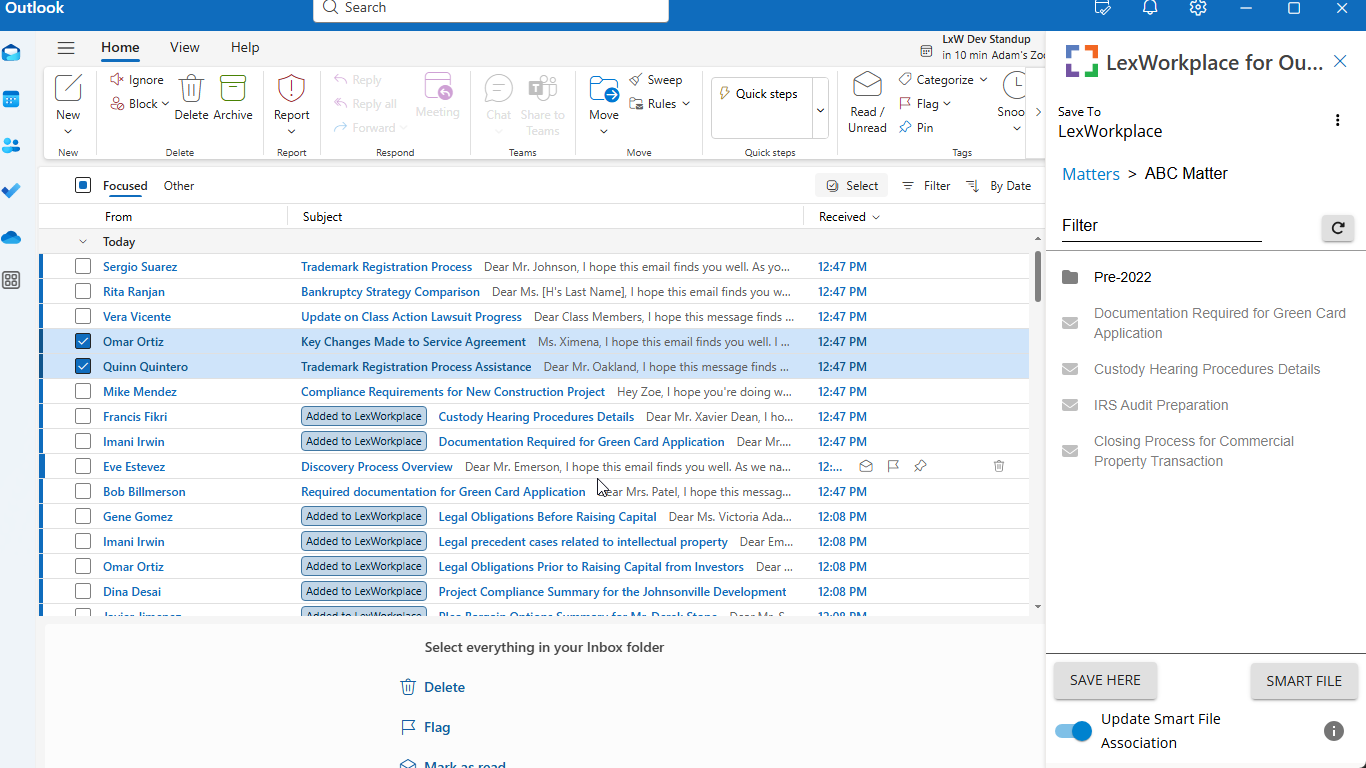Applies To
LexWorkplace Starter, Core, Advanced
In addition to being able to save emails directly to a Matter, LexWorkplace can also learn what senders you associate to which Matter.
This functionality is called Smart-File and is a core part of LexWorkplace’s email management capability.
Here’s how it works.
Requirements
First, a few important requirements.
Smart-File, along with most email management functionality, requires the latest version of LexWorkplace for Outlook (the Outlook add-in for LexWorkplace). The latest version of LexWorkplace for Outlook is available on the Microsoft Store. Learn more about the different Outlook Addin Versions.
Smart-File, along with most email management functionality, requires a Microsoft 365 subscription. LexWorkplace for Outlook is not compatible with on-premise or hosted Exchange. Learn more about System Requirements.
Smart-File, along with all LexWorkplace for Outlook functionality, requires your Microsoft 365 Administrator to perform a simple but important action, within your firm’s Microsoft 365 account/organization. This allows LexWorkplace to communicate directly with your Microsoft 365/Exchange service. Learn more about LexWorkplace for Outlook M365 Admin Setup.
Saving Emails to a Matter
Using LexWorkplace for Outlook, the LexWorkplace Outlook add-in, you can save one or more emails to a Matter (or a subfolder within a Matter).
This is accomplished by selecting one or more emails in Outlook, then clicking Add to LexWorkplace in the Outlook ribbon.
Next, select the Matter you’d like to save this Email to (and optionally browse into subfolders). Click Save Here to save the selected email(s) to this location.
Use of LexWorkplace for Outlook and general instructions on email management in LexWorkplace are described in detail here.
After saving emails to a Matter in this way, you’ll see the email(s) in the Email tab of that matter.

Remembering Sender/Matter Associations
When saving Emails to a Matter via LexWorkplace for Outlook (add-in), you’ll also see a toggle in the add-in sidebar: Update Smart-File Association

When you enable this toggle (which is off/disabled by default), LexWorkplace will remember that the selected sender(s) (email addresses) are associated with the selected Matter.
Using this toggle in LexWorkplace for Outlook will build a memory of email-address-to-matter associations, similar to the table below.
Email Address (Sender) | Associated Matter | |
|---|---|---|
john.smith@abcfoods.com | → | ABC Foods vs. Corons |
alison.anderson@xyzcorp.com | → | XYZ Entity Formation |
bill.reginald@xyzcorp.com | → | XYZ Contract Dispute |
Going forward, you can automatically save future emails from this sender to the associated matter in one click, without having to browse to and find the matter. This is called Smart-Filing.
Here’s how to do it.
How to Smart File
To Smart-File One or More Email(s): Select one or more emails in Outlook, then click Smart-File in the Outlook (look for the Uptime Legal square icon).

Email. Lots of Email.
You can select and Smart-File up to 100 email messages in Outlook at a time.
When you click Smart-File, LexWorkplace will perform the following actions for each selected email:
Check to see if this sender (email address) has a Matter association, as described above, then:
Check for any duplicates/emails already in this Matter (per LexWorkplace’s normal Email Deduplication functionality)
Present a summary screen of options/available actions, before finally executing the Smart-File operation.
Smart-File Summary Screen
When you attempt to Smart-File multiple emails at once, each of the emails you’ve selected:
May or may not have a Sender/Matter association
May or may not be a duplicate email (already saved to this Matter
May or may not be accessible to you (for instance, permissions to the associated Matter may have since been removed by a Firm Admin, or the file may have since been moved to the Trash Bin.
To summarize the “state” (smart-file-ability) of all selected emails, LexWorkplace for Outlook will present the following summary screen, before executing any actions.

Here LexWorkplace will present all available options, with the recommended option/path forward as a blue button. From here you may proceed with the Smart-File operation, and LexWorkplace will carry out your designated actions on each selected email.
Managing Smart-File Associations
Each time you select Update Smart-File Association when saving an email to a Matter, LexWorkplace remembers this Sender/Matter association. Users can view and edit their memorized associations, which is useful as associations build over time.
This is done by navigating to:
Settings > Exchange & Email > Manage Smart-File (Email/Matter) Associations

Here you’ll see each association that’s been created, including the Sender (unique email address), the associated Matter, and the associated Client (for that Matter).
From here you can:
Edit any association (change the Matter that’s associated with a given email address)
Delete individual Sender/Matter associations
Delete all associations
(Note that you cannot create new Sender/Matter associations from this screen; new associations can only be made via the LexWorkplace for Outlook add-in.)
Associations are Per-User
Sender/Matter associations are per-user, not firm-wide. This means that you can associate client@abc.com to Matter A, and another user in your firm can associate the same sender to Matter B.
Related Resources
Take a look at these related How-To’s and Email management resources.